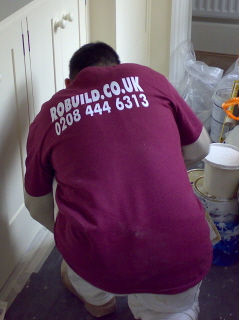Always work in a set order. If you work in a house where wood–boring insects are particularly troublesome, start by painting the underside of the unit. It is nearest the floor, and therefore most vulnerable. If not, forget the underside and start on the back where, while you get into your stride, any faults will show up least and then do the sides. Next, paint the larger top and front areas and finally the narrow dividing strips. Never paint the slides on which drawers run or they won’t.
The primer comes first. Its function is to bind loose particles and form a tough, non-porous surface for the undercoat. Pour into the paint kettle just enough primer to cover HALF the depth of bristle in your brush. There should never be more paint than this in the kettle. By using a paint kettle you avoid the inevitable consequence of painting from the original tin, a build-up of thick sticky paint around the rim which prevents you from getting an air-tight seal when you close the lid. And, by filling the kettle to the right depth, you avoid overloaded clogged-up brushes which are hard to clean.
Dip the brush into the primer. Wipe off any surplus paint from the inside of the kettle, not the rim, and lay on the primer with firm strokes along the grain of the wood until you have a smooth finish. Wipe off the dust with a rag dampened with thinners. Clean the paint kettle and brush with thinners, the back of the paint tin will tell you which kind.


